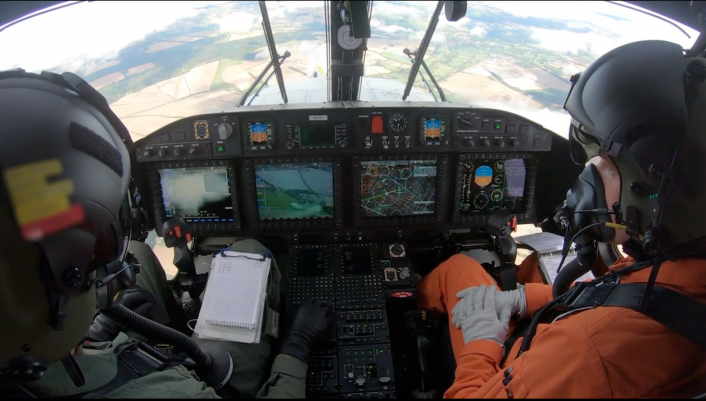Leonardo successfully tested the integration of the UAV control station into the Wildcat Mission System.
On Sept. 17, 2020, during Manned-Unmanned Teaming (MUMT) trials between an AW159 Wildcat helicopter and a semi-autonomous UAV from Callen-Lenz Associates, Leonardo successfully demonstrated how the helicopter crew could control the unmanned aerial vehicle from the helicopter like it was an onboard sensor being controlled from the cockpit.
The demonstration was part of the British Army’s MUMT themed Army Warfighting Experiment (AWE) 19, and was planned and executed by Dstl and took place on Salisbury Plain, in the south western part of central southern England, UK.
“By integrating control of the UAV into the Wildcat Mission System, Leonardo was able to minimise the pilots’ workload allowing them to focus more on the mission whilst simultaneously controlling the UAV – this is the first time such an integrated capability has been demonstrated in the UK on a military aircraft,” says a company press release. “A ‘Gateway Processor’ supplied by Callen-Lenz Associates was used to interface with its semi-autonomous UAV.”
The solution tested by Leonardo provides a LOI (Level of Interoperability) 4: the Wildcat crew could remotely control both the flight patch and payload of the UAV using “an efficient and effective task based Human Machine Interface (HMI), rather than the more operator intensive approaches employed on other systems.”
Here’s a video about the test.
The combination of the two platforms provide some great advantages in a Land and Maritime tactical scenario, increasing the situational awareness, tempo, lethality, survivability and combat mass of aviation forces, while significantly reducing crew workload. Pilots can focus on the mission at hand delegating some of the tasks to the drone, that becomes a detached sensor of the helicopter, able to operate closer to area of interest, as the manned platform remains at safe distance.
The Wildcat, already in service with the British Army and Royal Navy, is a multi-role helicopter that can perform battlefield reconnaissance, command and control, transportation and force protection, as well as and shipborne helicopter roles, including an anti-surface warfare.
The AW159 is a much modified and updated helicopter based on the Lynx. It has a semi-rigid rotor head to give it high agility and is fitted with composite rotor blades utilising the same technology that enabled the Lynx to break the world helicopter speed record. Its pair of CTS800-4N engines, have exhausts which include built-in IR suppression to enhance survivability.
The cockpit features four large area (10” x 8”) displays and a fully integrated avionics suite and mission system. One of these was used to display the live video feed coming from the remotely controlled UAV. Infra-red and daytime color imagery is provided through a nose mounted Electro Optical Device which incorporates a laser range finder. Naval variants are also equipped with a 360 degree scan radar and weapon carriers for a range of torpedoes, depth charges and anti-surface missiles.

Loyal Wingman
The teaming between manned and unmanned platforms is being consistently explored. Some Air Forces and aerospace companies are evaluating loyal wingman as well as drone-swarming concepts that both rely on tethering UAV of various sizes to a sort-of mothership.
For instance, the U.S. Air Force is currently evaluating the XQ-58 Valkyrie for a possible loyal wingman role and as communication relay platform for the F-22 and F-35. Boeing is involved in talks with the U.S. Department of Defense to understand the specific mission needs and requirements for a potential ATS offer.
In February 2020, Boeing and the U.S. Navy tested the manned-unmanned teaming also by flying two “unmanned” EA-18Gs Growlers from the backseat of a third one. The aircraft performed 21 different missions during four flights. While not officially stated, the results of the test may have applied to the ATS and its manned-unmanned teaming system interface and, maybe, to determine how much the U.S. Navy and the Department of Defense may be interested in the loyal wingman proposed by Boeing.
Darpa has also successfully test-flown a second X-61A Gremlins Air Vehicle (GAV), as well as the Gremlins airborne recovery system, the company announced on Aug. 26, 2020. The testing was carried out last month at Dugway Proving Ground in Utah for the Defense Advanced Research Projects Agency (DARPA).









